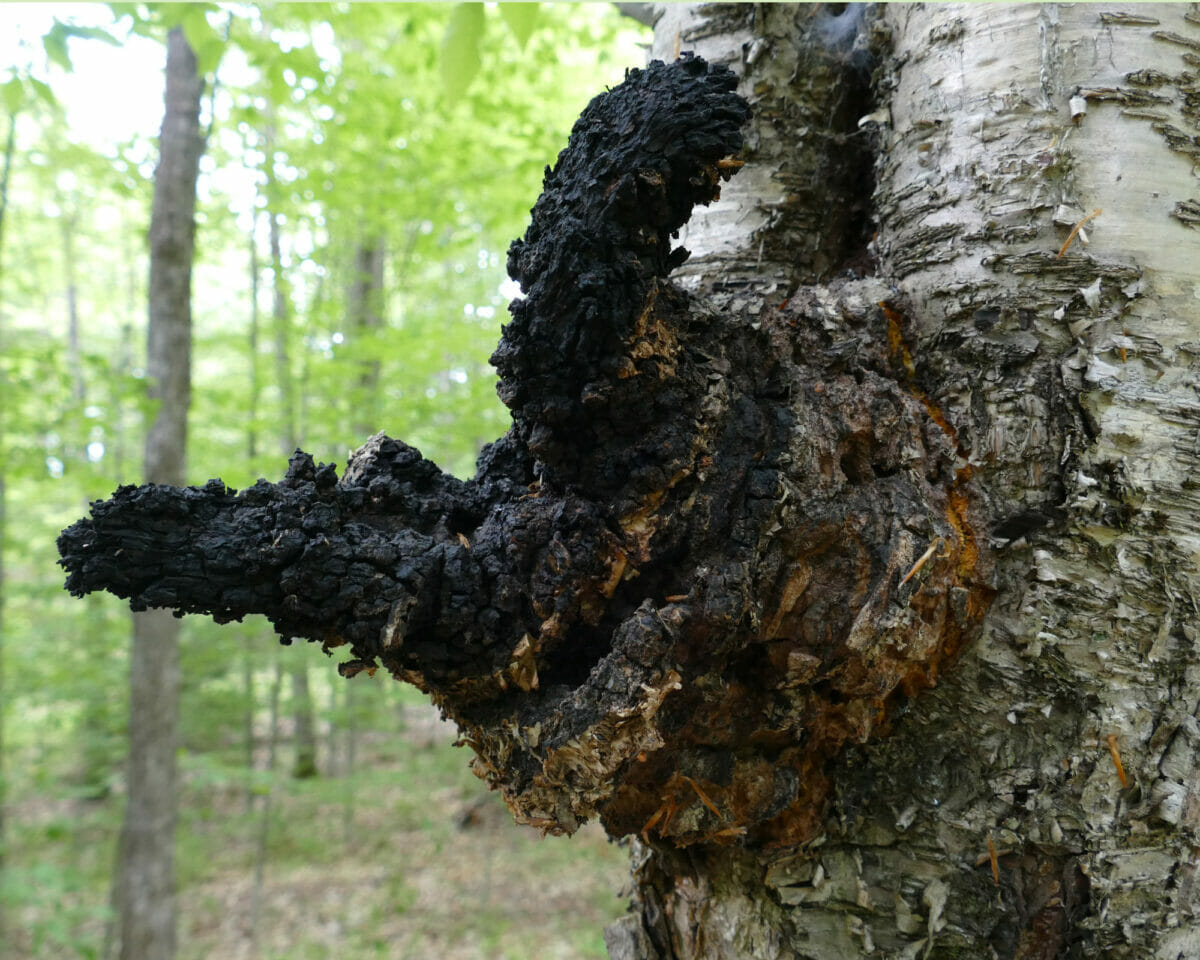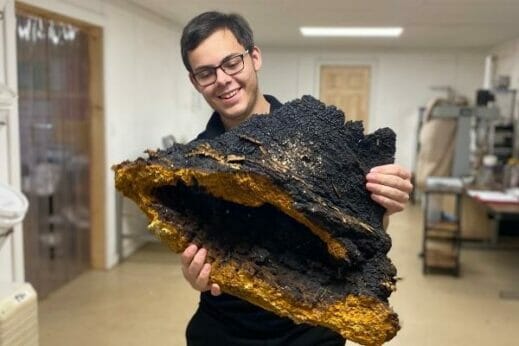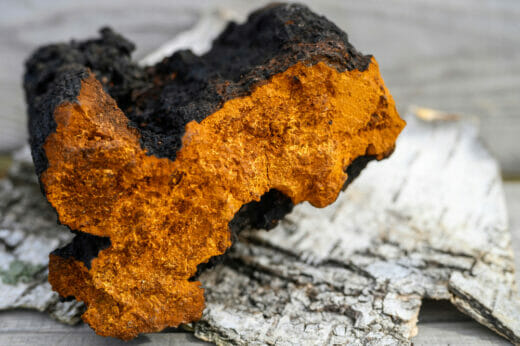Chaga, a fungus found in colder climates, is a trendy ingredient in supplements and functional foods. But some foragers worry the supply is growing thin.

Garrett Kopp learned to harvest wild chaga alongside his grandmother in the Adirondack Mountains of New York when he was a teen. In 2015, at 16 years old, his first stop after getting his driver’s license was the Franklin County Clerk Office where Kopp registered his new business—Birch Boys Chaga. The company has been harvesting and selling chaga ever since. Kopp says the demand for chaga spiked in 2020 and remains steady. “We brought in 3,000 pounds of chaga this year—more than we ever have. The market has grown, and it looks like it’s here to stay.”

Garrett Kopp with foraged chaga. Photography courtesy of Kopp.
You’d be forgiven if you’ve never heard of chaga—the parasitic fungus isn’t exactly well known outside of wildcrafting communities. It infects many species of trees, most notably birch, and erupts as a crusty black mass of hardened fungal hyphae (called a sclerotia). It’s not exactly the traditional muse of poets and painters looking to nature for inspiration. Found in boreal forests and sub-arctic forests in Canada, parts of the US, Siberia, Scandinavia and other suitably cold climates, chaga has featured prominently in the folk medicine of various northern cultures. The fungus is now enjoying a renaissance of sorts in North America as interest in functional foods and adaptogens intensifies. A quick perusal of Amazon reveals a staggering amount of chaga products: tea, tinctures, powders, chunks and capsules.
But what does science say? Is chaga deserving of all the recent praise? The answer is an unsatisfying “maybe.” A 2010 study found that chaga extracts reduced glucose levels in diabetic mice by up to 36 percent. Another study exploring antioxidant effects showed cells pre-treated with chaga had 40 percent less oxidative damage from free radicals than cells that were not treated. A 2022 study investigated the anti-inflammatory properties of chaga and found a new extraction method reduced nitric oxide production, which can spur inflammatory disorders, by 58 percent.
The most intriguing finding, however, is chaga’s anti-tumor activity. Numerous studies have demonstrated chaga’s ability to destroy different types of cancer cells (i.e., sarcoma, lung adenocarcinoma, colon cancer, melanoma and bladder cancer). But without large-scale human trials, its ultimate clinical effectiveness remains unknown.
However, by the time we have sufficient evidence to evaluate its clinical benefits, chaga may be a scarce commodity. Many are worried that increasing market demands are putting excessive pressure on this natural resource.
Disconcertingly, we don’t have a good understanding of current distribution or population trends. Experts do know that chaga contributes to important nutrient recycling and carbon sequestration, and mycology experts fear we are harvesting large quantities of this organism without understanding the long-term ecological impact.
When it comes to chaga harvesting, sustainability is complicated by a number of factors. Chaga is very slow growing and takes decades to form reproductive structures. But harvesting only occurs in the pre-reproductive form, meaning foragers take the fungus before it’s had a chance to produce spores.
“Timber-centric” foresters also endanger chaga—placing little value on any part of the forest ecosystem outside of timber. Yellow birch trees infected with chaga (considered a parasite that ruins the timber value) are targeted for destruction. This year, Birch Boys managed to intervene and salvage 500 pounds of chaga from birch before they were decimated, but that’s only because they’ve established a personal relationship with one of the foresters. Kopp says many people aren’t aware that logging and deforestation threaten chaga populations.

Photography by Shutterstock.
In the Adirondacks, Kopp estimates they’re 10 to 12 years away from a real chaga shortage, but he’s hopeful efforts to wild-farm chaga will change that trajectory. Birch trees can be inoculated with chaga by drilling holes in the trunk and inserting dowels with live chaga mycelium. KÄÄPÄ Forest, a Finnish company, is doing just that—creating the largest chaga cultivation network in the world. After researching and testing dozens of mushroom strains to optimize germination and growth speed, the company has started signing cultivation contracts with farmers in Finland, promising to buy the chaga back from these farmers at the agreed market price when it is harvested. This requires a lot of patience—farmers can expect to wait 10 years before harvesting their crop. KÄÄPÄ Forest expects its first crop in 2028 and estimates a harvest of 11,000 pounds. By 2031, yields are expected to rise to 141,000 pounds with estimated sales of $8.5 million.
Eric Puro serves on the board of the International Medicinal Mushrooms Society and is the CEO of KÄÄPÄ. He sees chaga cultivation as an important conservation effort and says it also offers ecological benefits such as increasing forest diversity and carbon sequestration. “Low-yield birch trees that would normally be thinned will remain in the forest,” he says. According to Puro, Metsähallitus (the Finnish Forest Administration) believes that KÄÄPÄ’s chaga cultivation forests will sequester about 50,000 tons of carbon annually.
Finland is the only country in the world tackling the problem of overharvesting at a national level. The government issues harvesting permits and only allows foraging in areas deemed ecologically stable. Regulations stipulate that Finland can sustainably harvest about 44,000 pounds of wild-foraged chaga per year—“a drop in the bucket,” according to Puro, who estimates global chaga consumption to be at least one billion pounds per year.
Back in the Adirondacks, Kopp is eagerly looking for land partners and has a lease agreement in hand. Birch Boys is venturing into cultivation and needs access to birch trees. Like Puro, he believes wild farming—and diversification of land management as a whole—will play an important role in chaga’s future.
Wow! So interesting. One of these days…a cure for cancer might be found.
Great article! There is a company right here in Maine that does this commercially too, just like you describe. They are all over the news here and have been for the better part of the last 8 months or so. https://youtu.be/ns2YhxfaZCY
I met them at our annual foresters conference early this spring. They are very friendly and knowledgeable!
Excellent article!
I am intrigued by the chaga products.
I used to grow mushrooms, so I know that actually growing and caring for this food is not easy. The weather and environmental conditions of the fungi are the prerequisites affecting the growth of the fungus.
I found your article on the rising trend of Chaga fascinating! As someone who enjoys exploring natural remedies, it’s exciting to see the increased interest in this unique fungus. The insights from mycologists added a thoughtful perspective, and it’s essential to consider sustainability in the harvesting process. Your article struck a perfect balance between highlighting the trend and raising awareness about potential challenges. Great read!
My husband has recently been diagnosed with bladder cancer and has been treated with resection and chemo! I know the healing effects of Chaga and have purchased some from Siberia. I met a woman yesterday in price chopper and we got to talking, long story short her father had bladder cancer and she treated him with high doses of chaga, no chemo no surgery cancer gone! God has given us all the tools right here growing, we’re just so dependent on what the doctors say then to use medicinal plants! I will begin a chaga treatment for my husband and… Read more »